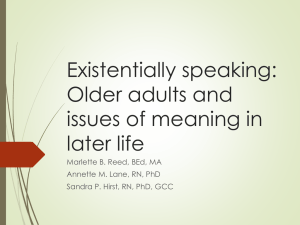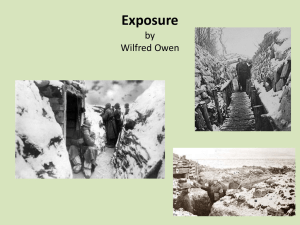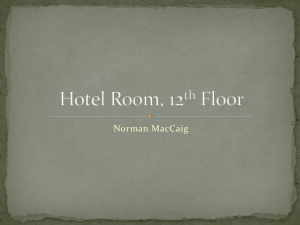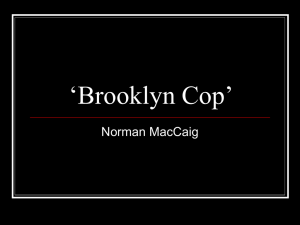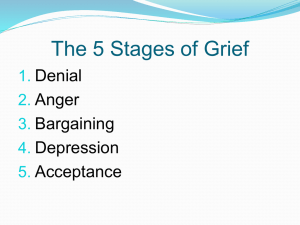Memorial Annotation 1
advertisement
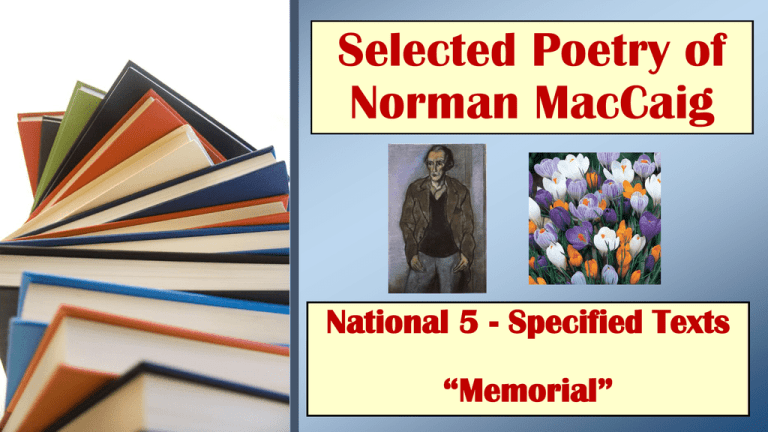
Selected Poetry of Norman MacCaig National 5 - Specified Texts “Memorial” “Memorial” by Norman MacCaig Learning Intentions I will: • Develop my understanding of MacCaig’s work by studying, in detail, the techniques used by the poet and their effectiveness within the poem “Memorial”. • Identify the writer’s main theme and recognise how it relates to my own and others’ experiences • Identify and make a personal evaluation of the effect of aspects of the writer’s style and other features appropriate to genre using some relevant evidence and terminology. Success Criteria • I can: • Confidently discuss aspects of MacCaig’s work (such as language and imagery) using supporting evidence with my group. • Confidently answer a variety of questions on the work of Norman MacCaig • Confidently contribute my opinion and encourage others to express themselves Memorial • A memorial is an object which serves as a focus for the memory of something, usually a person (who has died) or an event. • Popular forms of memorials include landmark objects or art objects such as sculptures, statues or fountains, and even entire parks. • The most common type of memorial is the gravestone or the memorial plaque. Also common are war memorials commemorating those who have died in wars. Listening Exercise - Questions 2. What event, according to MacCaig changed ‘death’ from more than just a concept? (1) 3. What examples does MacCaig use to show he has not really experienced death or grief until later in life? (2) 4. Why do you think MacCaig has written this poem? (1) Listening Exercise - Answers 2. What event, according to MacCaig changed ‘death’ from more than just a concept? (1) The death of his friends. 3. What examples does MacCaig use to show he has not really experienced death or grief until later in life? (2) He has survived two wars and his parents both died in old age. 4. Why do you think MacCaig has written this poem? He has written this poem in memory of his wife. (1) “Memorial” Everywhere she dies. Everywhere I go she dies. No sunrise, no city square, no lurking beautiful mountain but has her death in it. The silence of her dying sounds through the carousel of language. It’s a web on which laughter stitches itself. How can my hand clasp another’s when between them is that thick death, that intolerable distance? “Memorial” She grieves for my grief. Dying, she tells me that bird dives from the sun, that fish leaps into it. No crocus is carved more gently than the way her dying shapes my mind. – But I hear, too, the other words, black words that make the sound of soundlessness, that name the nowhere she is continuously going into. “Memorial” Ever since she died she can’t stop dying. She makes me her elegy. I am a walking masterpiece, a true fiction of the ugliness of death. I am her sad music. A closer look at “Memorial” Structure • Everywhere she dies. Everywhere I go she dies. • No sunrise, no city square, no lurking beautiful mountain • but has her death in it. Structure Short sentences add dramatic emphasis to opening. • Everywhere she dies. Everywhere I go she dies. • No sunrise, no city square, no lurking beautiful mountain • but has her death in it. Repetition of “Everywhere” highlights how much the death has affected the speaker. This idea is continued with repetition of “No” in following line. Structure • How can my hand • clasp another’s when between them • is that thick death, that intolerable distance? Structure • How can my hand • clasp another’s when between them • is that thick death, that intolerable distance? Poet uses enjambment to highlight the distance between himself and his wife. Structure • No crocus is carved more gently • than the way her dying • shapes my mind. – But I hear, too, • the other words, • black words that make the sound • of soundlessness, that name the nowhere • she is continuously going into. Structure • No crocus is carved more gently • than the way her dying • shapes my mind. – But I hear, too, • the other words, • black words that make the sound • of soundlessness, that name the nowhere • she is continuously going into. Poet shows a change of tone here, suggesting a growing fear of death. Structure • I am a walking masterpiece, • a true fiction • of the ugliness of death. • I am her sad music. Structure • I am a walking masterpiece, Final line is simple and short to give it • a true fiction more emphasis. He compares • of the ugliness of death. himself to being the • I am her sad music. ‘sad music’ of her funeral. Free verse is used throughout, which reflects the poet’s confused feelings on her death. Imagery • The silence of her dying sounds through • the carousel of language. It’s a web • on which laughter stitches itself. Imagery • The silence of her dying sounds through • the carousel of language. It’s a web • on which laughter stitches itself. Her death is now a web- he is unable to free himself from its hold. The word “stitches” suggests this hold is very strong. As a poet, words are hugely important to him. What he saw as a fun, bright, colourful and musical ride is now silenced by her death. Imagery • No crocus is carved more gently • than the way her dying • shapes my mind. – But I hear, too, • the other words, • black words that make the sound • of soundlessness, that name the nowhere • she is continuously going into. Imagery • No crocus is carved more gently • than the way her dying • shapes my mind. – But I hear, too, • the other words, • black words that make the sound • of soundlessness, that name the nowhere • she is continuously going into. Compares her death to a crocus flower- beautiful, natural and fragile. Imagery • No crocus is carved more gently • than the way her dying Compares her death to a crocus flower- beautiful, natural and fragile. • shapes my mind. – But I hear, too, • the other words, • black words that make the sound • of soundlessness, that name the nowhere • she is continuously going into. Later in the stanza the imagery becomes much darker- these black words suggest a nothingness- the poet believes there is nothing after death. Word Choice • “is that thick death, that intolerable distance?” Word Choice • “is that thick death, that intolerable distance?” The poet uses the word thick, which is a strange word to use to describe death. It suggests it is surrounding him, like a fog perhaps. It also emphasises the distance that keeps him apart from others. Word Choice • “She grieves for my grief.” • “the sound of soundlessness” • “Ever since she died she can’t stop dying.” Word Choice • “She grieves for my grief.” She is sorry that he will be grieving for her. • “the sound of soundlessness” • “Ever since she died she can’t stop dying.” Word Choice • “She grieves for my grief.” • “the sound of soundlessness” She is sorry that he will be grieving for her. Absolute silence. • “Ever since she died she can’t stop dying.” Word Choice • “She grieves for my grief.” • “the sound of soundlessness” She is sorry that he will be grieving for her. Absolute silence. He is • “Ever since she died she can’t stop dying.” always thinking about her. Word Choice • “She grieves for my grief.” • “the sound of soundlessness” The poet uses She is sorry that he will paradoxes be grieving forwithin her. the poem. These suggest that Absolute silence. he cannot make sense of his wife’s death. • “Ever since she died she can’t stop dying.” Themes • Thinking about the poem as a whole, what do you consider the main ideas or themes of the poem? Key Themes • Facing Death (either the dying person, or the relative) • Isolation surrounding death/emotion Class Discussion Think about… • Is it less of an ordeal for the dying person than the one left behind? • Dying is something we have to do alone, despite being surrounded by loved ones? • How realistic do you find the poet’s feelings?


